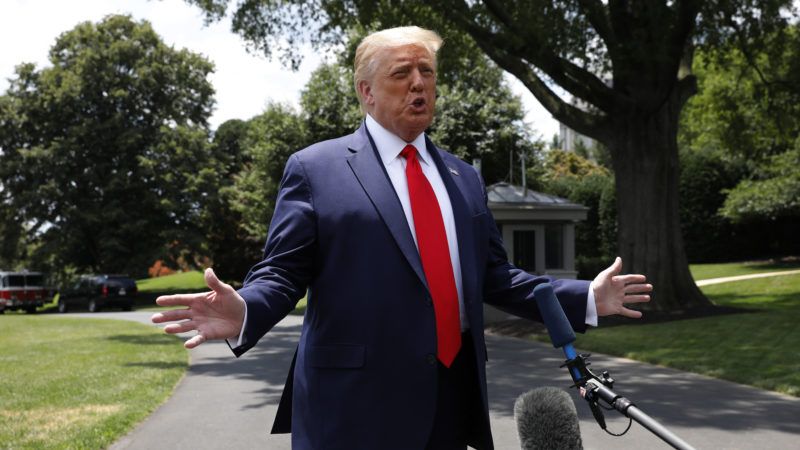Trump Administration Data Claims Coronavirus Relief Program Saved Tens of Thousands of Jobs That Probably Don't Exist
White House brags about the supposed success of the coronavirus relief program are based on shoddy data.

In April, the White House released a statement boasting that President Trump had signed into law a bill authorizing an additional $320 billion in spending on the Paycheck Protection Program (PPP). The additional funds, which were intended to provide forgivable loans to small businesses negatively impacted by the pandemic, would bring the program's total funding to about $670 billion, making it one of the largest emergency government spending measures ever undertaken.
The White House argued that the spending was justified, as the program had already proven to be "incredibly successful" aiding "countless small businesses and millions of American workers." The program, the statement said, had "already experienced unprecedented success in protecting American jobs and small businesses." More recently, the administration has attempted to place a figure on the number of jobs saved, saying it supported more than 51 million positions, and deeming the program a "wild success."
That was the argument: support for jobs and small businesses in a time of crisis. Yet as more details about the program have slowly been released, it has become clear that the administration's claims are unreliable and inflated, perhaps wildly so. Indeed, there is reason to believe that thousands of the jobs the administration claims to have saved do not exist at all.
In addition to small businesses, a number of large employers and wealthy firms received loans under the program, according to the administration's own data.
Kanye West's Yeezy clothing company received a loan of at least $2 million through the program, as did various well-connected political organizations and consulting groups, national restaurant chains like P.F. Chang's, and pricey educational institutions like the Sidwell Friends School in Washington, D.C. Several companies that received government loans were owned by billionaires.
These loans were loans in name only; as long as recipients followed certain rules, they were fully forgivable, making them more like federally funded grants. Meanwhile, there were few if any checks or verification procedures built into the program, meaning that loan approvers did little to determine if recipients actually needed the loans to stay afloat. This was essentially free government money for any business that asked for it and could navigate the application process.
Meanwhile, the administration's jobs-saved claims are almost certainly inflated. The Washington Post reports that multiple businesses have total employment that is far lower than the figures shown in White House data. A fire protection company based in Washington state, for example, supposedly saved 500 jobs with its PPP loans. The company employs just 20 people. A manufacturer in Georgia has just seven employees and two owners, but according to White House data somehow saved more than 500 jobs. The owner appears to be as confused by this as anyone, telling the Post, "I don't know where you got the 500."
The problems don't appear to be just one-off data entry errors. The Post also notes that administration data claims the PPP saved 114,000 landscape architecture jobs. That's somewhat suspicious, as it's more than triple the total number of people in the field, according to separate government data. The administration is claiming that it saved far more landscape architecture jobs than there are in the country.
Nor is this discrepancy limited to a single field. The Post reports that in multiple employment sectors—such as oilseed and grain farming, employment placement, and performing arts—Trump administration data shows thousands more jobs saved by PPP than actually exist.
The data is questionable in other ways as well. As Reuters recently reported, an unusually large number of recipients reported saving exactly 50 jobs.
None of this has stopped Trump from declaring that the program has been a runaway hit. "This has been a tremendous success; levels that nobody has ever seen before," he said earlier this month. Given the general shoddiness of the administration's data, it's worth taking these presidential brags with considerable skepticism. But it is probably true that no one has ever seen levels of success that include saving jobs that never existed in the first place.
Still, these sorts of dubious and likely inflated claims are far from unprecedented. Following the passage of the 2009 stimulus bill, the Obama administration repeatedly bragged about the millions of jobs "created or saved" by the program.
But the jobs figures were based on models and extrapolations from the Congressional Budget Office that simply assumed that certain government spending levels always created a particular number of jobs, rather than actual measurements of jobs created. Attempts to actually measure employment created by the program, in contrast, showed a much more complex picture, in which many of the jobs created were just hired away from other firms, rather than jobs for people who had been out of work.
Like Trump, however, the Obama administration declared the program a success anyway. The point person for the oversight effort? Trump's presumed Democratic rival for the presidency, Joe Biden.
Show Comments (25)